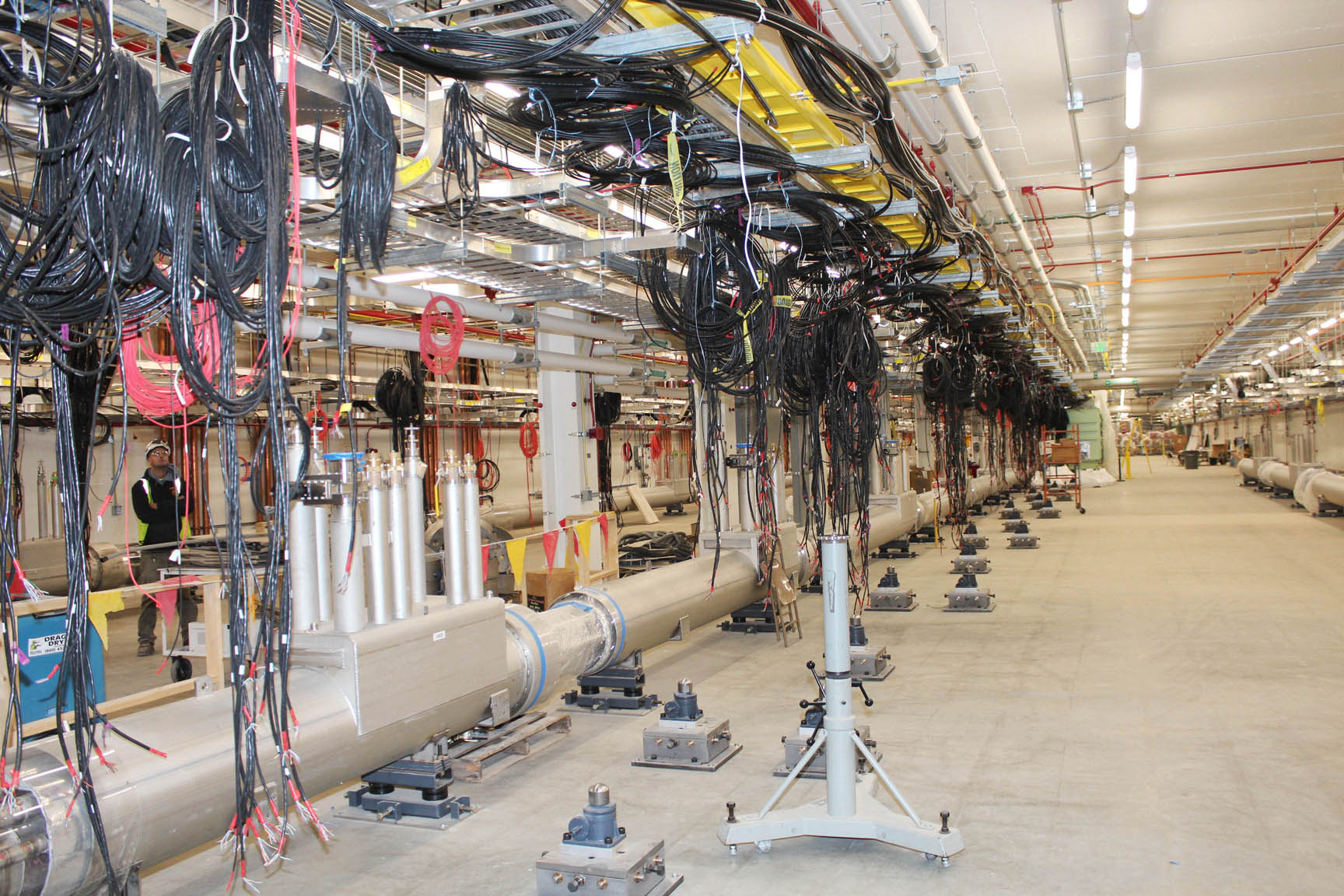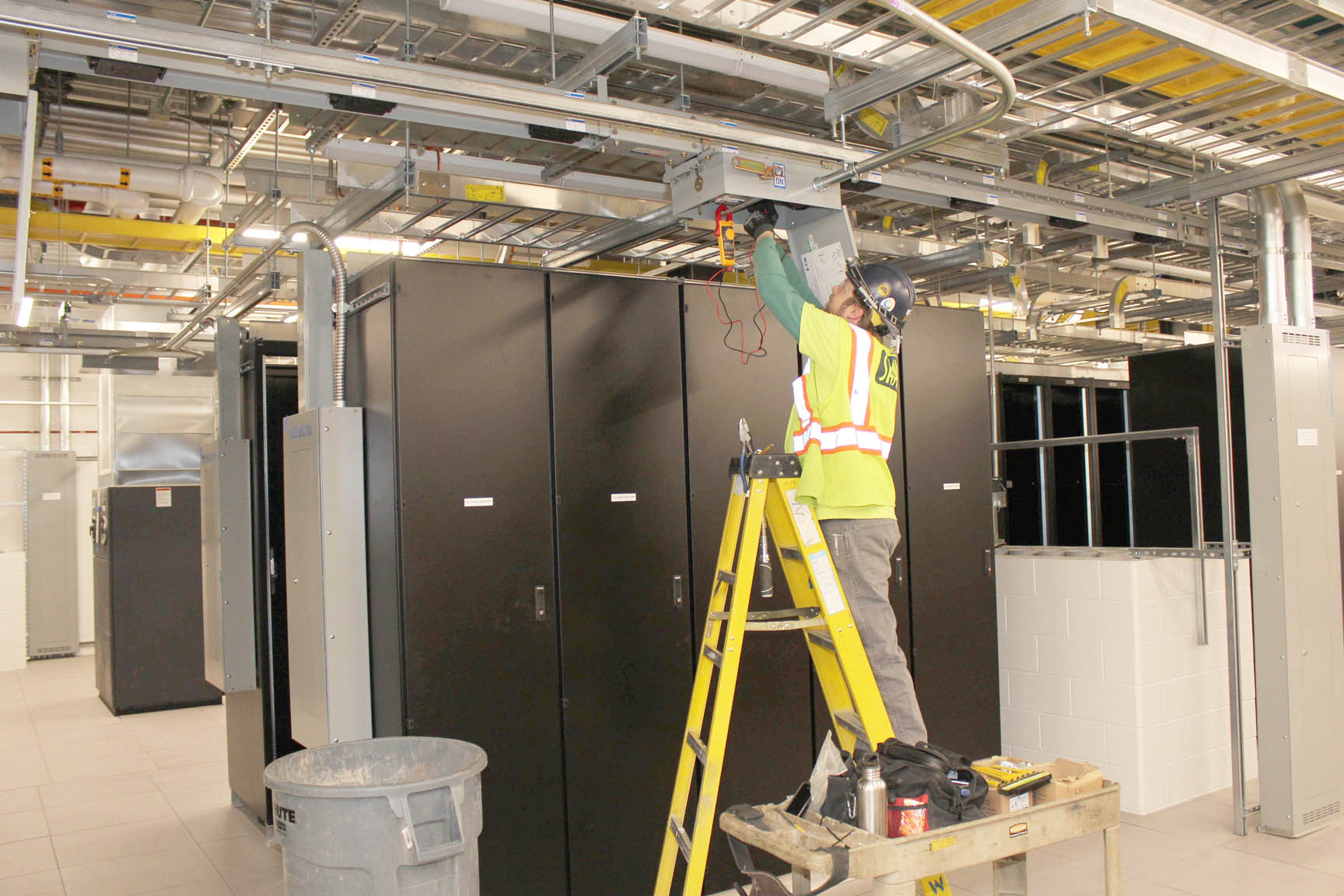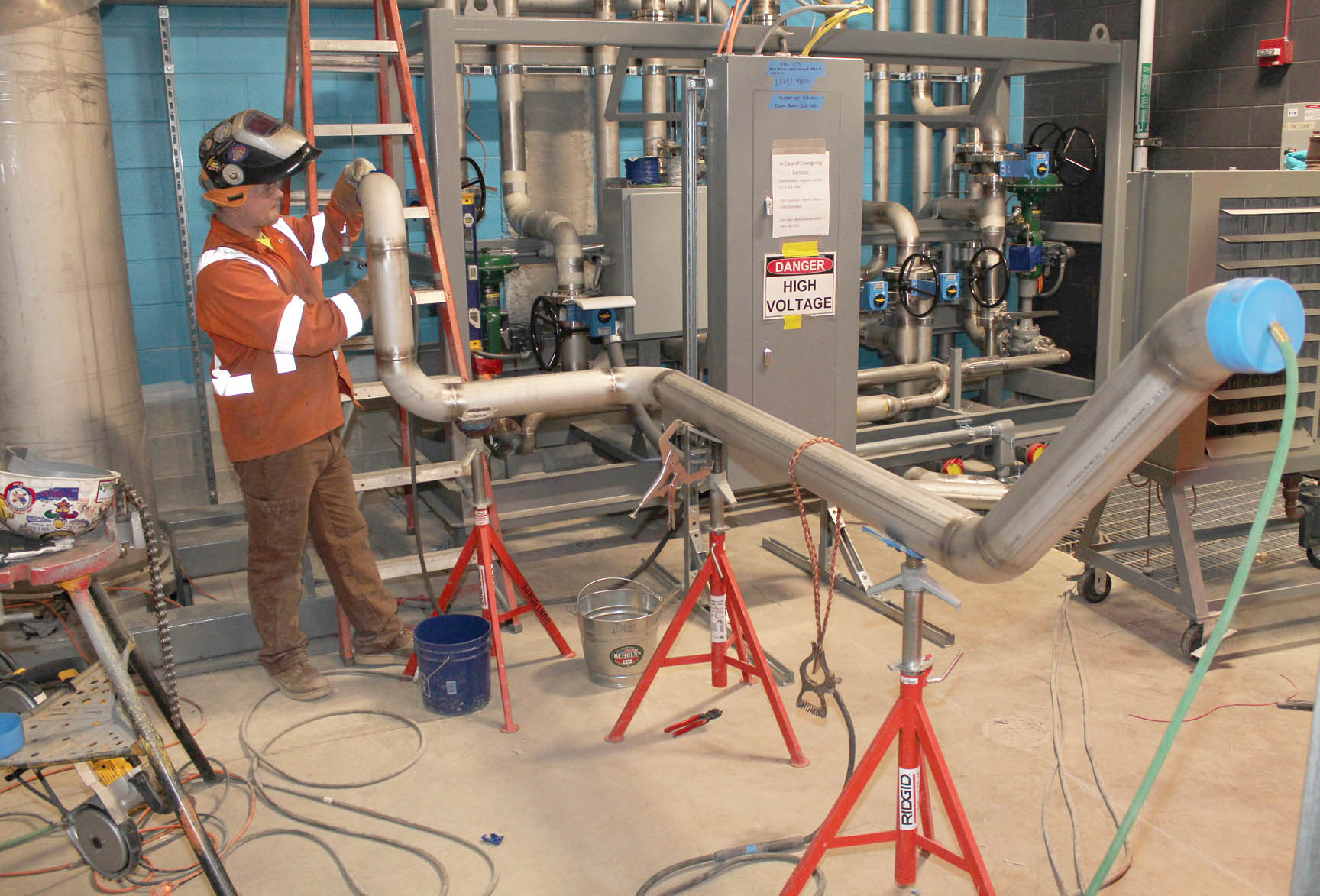A win for nuclear science as FRIB nears construction hurdle
Date Posted: March 3 2017
EAST LANSING - Civil construction of the most powerful rare isotope accelerator in the world is nearing substantial completion.
Michigan State University's Facility for Rare Isotope Beams (FRIB) is on target for substantial completion on March 17 - two-and-a-half months ahead of schedule - under a team led by construction manager Barton Malow and a host of talented subcontractors.
Construction on the project began in March 2014, and the 90 or so trades workers who remained last month were primarily performing finish work, and assisting with the installation and testing of technical components associated with the building's scientific mission, including cabling and stainless steel cryogenic piping installation.
"It's been a really well done job," said Brad Bull, FRIB's conventional facilities and infrastructure division director. "We're well ahead of schedule, and we couldn't be happier with the quality of the workmanship we have seen. The workforce has been amazing."
Michigan State won a rigorous merit-review process to design and build the $730 million isotope accelerator in 2008. Operated by university scientists and staff, the FRIB will provide intense beams of rare isotopes - short-lived nuclei no longer found on earth. The process will enable scientists to make discoveries about the properties of these rare isotopes in order to better understand the physics of nuclei, nuclear astrophysics, fundamental interactions, and applications for society.
MSU is establishing FRIB as a scientific user facility for the Office of Nuclear Physics in the U.S. Department of Energy Office of Science.
The FRIB complex consists of four buildings with a footprint of 499,885 square feet, at Bogue St. and Shaw Lane, adjacent to the university's existing National Superconducting Cyclotron Laboratory.
Civil construction alone came with a price tag of $200 million. Bull said civil construction proceeded in two directions, from the east and west. The east half was completed first and is currently in operation. FRIB staff have already produced the first "low-energy" ion beam from the Advanced Room-Temperature Ion Source (ARTEMIS), Bull said. Testing and installation activities continue, with the final goal of moving beam through the whole working accelerator at ever-increasing speed, providing the highest intensity beams at half the speed of light. That will happen with completion of the entire project, scheduled for June 2022.
The beam will be made in the linear accelerator tunnel at the site, measuring 570 feet long, 70 feet wide, and 13 feet high. Its floor is buried 32 feet underground.
Construction-wise, there is little that's "off the shelf" when it comes to the FRIB. Re-bar pieces around the tunnel are four times thicker than would be found on a typical floor slab. Iron workers said structural steel sections above the tunnel are among the widest and heaviest they have ever worked with. The FRIB's 25-megawatt electrical capacity comes from the local utility with backup power provided by MSU's T.B. Simon Power Plant.
Among some of the unique fixtures and features at the plant are:
*An RFQ - radio frequency quadrupoles - which prepares the beam for acceleration in the FRIB’s linear accelerator.
*An 85,000-lb. wedge vessel, which houses focusing magnets and a wedge assembly for beam momentum compression.
*Cryomodules. "The cryomodules themselves are just mind-boggling," Bull said. "You can touch the side of them, but inside they have a temperature of minus 450 degrees. Just inches away, and you have a temperature variation of hundreds of degrees difference."
*The linear accelerator tunnel's reinforced concrete walls, ceilings and floors, which are four-and-a-half feet thick up to 16 feet thick.
"There are no codes for this stuff," Bull said. "Everything is one of a kind. When you get down to it, our job was to build a structure to house all these instruments and a machine that will be unlike any other in the world. There are no offices, and three bathrooms. That's it. It's just a giant mechanical and electrical space. It is vastly different from any other kind of construction you'll see here on campus, or anywhere else."
The project utilized no less than three electrical contractors: Shaw Electric, Summit Contractors and Superior Electric. Daren Bebee of IBEW Local 665 and foreman for Superior Electric, has been on the job for three years.
"On behalf of my union brotherhood, I just want to say we've built an amazing facility," Bebee said. "It's been a beautiful part of the job to work with so many amazing scientists, at so many different levels of the project."
Bebee said the grounding system alone on the FRIB is "incredible," with 28 40-foot deep grounding rods sunk around the FRIB property, as well as copper-mesh encased in concrete above the accelerator tunnel. All the grounding is primarily to help contain electro-magnetic interference from the tunnel below to the computers above.
There is tremendous interest in the FRIB from scientists around the world. Approximately 1,400 scientists are engaged and ready for science at the FRIB. They have organized themselves into the independent FRIB Users Organization, with 19 working groups specializing in instruments and scientific topics. Members are from 109 U.S. colleges and universities, 12 national laboratories and 51 countries.
Bebee said the trades' interaction with the FRIB's scientists was personally one of the best parts of the job for him. "These are amazing, brilliant people, and the communication challenges we had weren't about language," he said. "The challenge was to help them understand what we're able to do on the construction side, and at the same time we're trying to understand what they want to do in order to make their instruments work properly."
When the FRIB is fully up and running in 2022, according to MSU, it will be able to accelerate a beam of stable nuclei to half the speed of light before it impinges on a thin target material. When the beam impacts the target, the resulting collision will create a number of reaction products, most with fewer protons and neutrons than the stable beam. Among those products will be the rare isotopes requested by experimenters. This mixture will continue to speed through a fragment separator, where a series of magnets will select the desired isotopes for study and send them to the experimental area, where scientists will use detectors to measure their unique properties or interaction with other nuclei.
With the FRIB, scientists will have the capability to produce most of the same rare isotopes that were created in the cosmos, which then decay into the elements found on earth. The process will help scientists understand the origins of the elements, and some of the future benefits of the research can lead to better understanding of how atomic nuclei can be used to diagnose and cure diseases, optimize the next generation of nuclear reactors, and evaluation of techniques to destroy nuclear waste. Modeling atomic nuclei and their interactions can also help lead to breakthroughs in energy, security, medicine, and the environment.
Bull said with rapid changes in technology, and the multi-year time-line for erecting the building, there have been routine changes in plans during the construction process. But of course, there came a point when the building had to be built. "You can optimize forever, but you have to draw a line somewhere," Bull said. He added that the building does have some elements that can be upgraded in the future, such as the power supply.
“FRIB will be the core of our nation’s research infrastructure, advancing knowledge in areas such as science, medicine and homeland security, as well as providing answers to questions we have even yet to conceive,” said MSU President Lou Anna K. Simon at the FRIB's groundbreaking. “This facility also will be a training ground for the world’s next generation of nuclear physicists and attract scientists and engineers from all corners of the earth, securing MSU’s position as the driver in the knowledge economy.”

THE FOCUS OF THE Facility for Rare Isotope Beams at Michigan State University is the Linear Accelerator Tunnel. Buried 32 feet below ground and encased in reinforced concrete, the tunnel is a high-tech wonder, and the data it will produce will be of interest to nuclear scientists around the world.

TESTING A DISCONNECT in the FRIB’s main level service building amid a bank of data cabinets is Aaron Nowland of IBEW Local 665. He’s employed by Shaw Electric.

READY TO WELD a stainless steel helium pipe at the FRIB is Dennis Gordon of Plumbers and Pipe Fitters Local 85. He’s employed by Gunthorpe.
